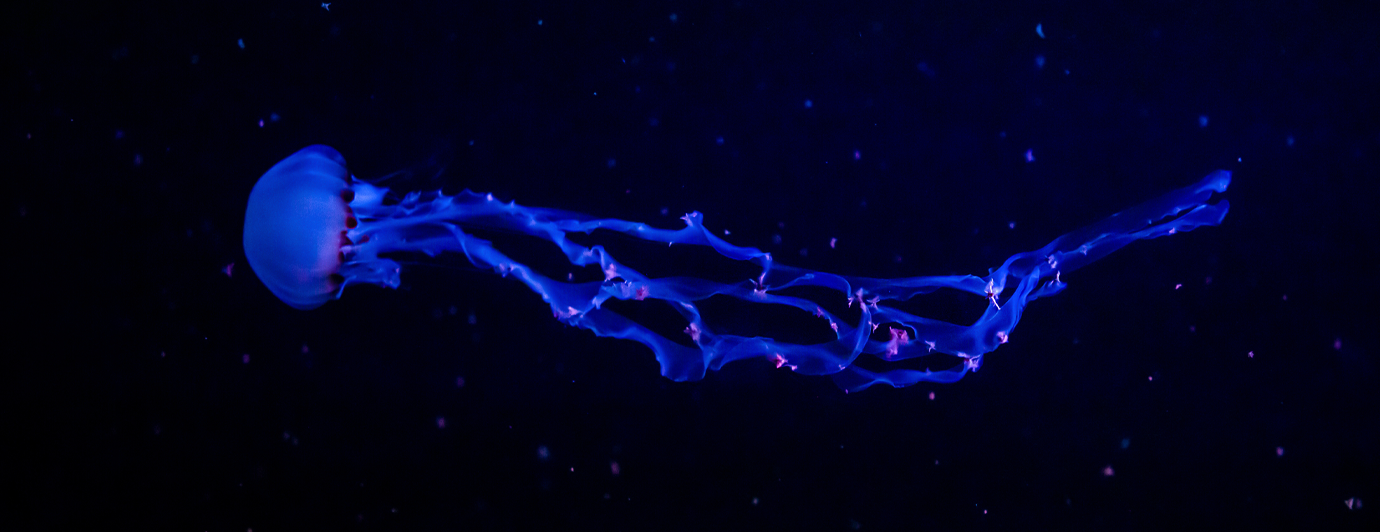While jellyfish are known for their venomous stings, there are a lot of non-stinging jellyfish species in the ocean. These beautiful and widely feared marine creatures are relatives of corals, anemones, and hydroids.
Here are some examples of Non-venomous jellyfish:

• Aequorea Forskalea: They have large umbrellas which are thick near the center but gradually thin as they reach the margin of the umbrella. The umbrella for this species may span up to 175 mm across. Despite containing a bioluminescent protein, aequorin, this species (as well as all other species in the genus) are almost completely colorless.

• Aurelia Aurita: They naturally die after living and reproducing for several months. It is probably rare for these moon jellies to live more than about six months in the wild, although specimens cared for in aquariums typically live several to many years.A recent study has found that they are capable of lifecycle reversal where individuals grow younger instead of older, akin to the "immortal jellyfish".

• Pleurobrachia Bachei: It is a selective carnivore and its feeding habits are analogous to other ambush "sit and wait" predators. When handling prey both tentacles contract and carry the prey to the mouth. This is achieved by several rapid rotations of the body which swipes the tentacle bearing the food across the oral region.

• Porpita Porpita: The blue button sting is not powerful but may cause slight irritation to human skin. However, in recent years, it has been hypothesized that due to global warming, colonies have begun appearing in larger numbers along coastlines in Japan and the first case of contact dermatitis from this species was recorded.

• Rhopilema Verrilli: They survive off of tiny plankton parts, which are pushed out of their umbrella by the water and are caught with their finger-like appendages. They do not present a stinging threat to humans because they do not have tentacles but stinging cells that reside inside their bells.
There are several species that have highly venomous stinging cells that can cause serious consequences for humans such as extreme pain or even death. Beware of these poisonous and deadliest jellyfish when you enter the water.
Here are some examples of Venomous jellyfish:

• Chironex Fleckeri: It is a species of extremely venomous box jellyfish found in coastal waters from northern Australia and New Guinea to Malaysia, the Philippines and Vietnam. It has been described as "the most lethal jellyfish in the world", with at least 64 known deaths in Australia from 1884 to 2021.

• Alatina Alata: The rash and pain caused byit's stings are self- limited, usually disappearing with no treatment from 20 minutes to one day. A few victims suffer generalized reactions, persistent pain and/or recurring, itching rash. No confirmed deaths have occurred from this box jellyfish's stings, but the pain they inflict can be severe.

• Irukandji: They are small and inconspicuous, but extremely venomous. This makes it hard for potential victims to see them before they are stung. Since there have been different outcomes for people that have been stung, scientists believe that as they mature its venom becomes stronger.

• Chiropsalmus Quadrigatus: They can inflict an extremely painful sting on people that encounter them. Apart from pain, the symptoms include cardiac dysfunction and respiratory depression. The rash lasts for several months. Antivenom administered within a few hours relieves the pain somewhat, reduces the severity of the rash, and improves other symptoms.

• Morbakka Fenneri: The sting from this species results in symptoms similar to Irukandji syndrome. The wound is typically 10mm wide and is followed by an immediate burning sensation. If left untreated, it can become necrose, pruritic, and vesicule.
Did you know?
Moon jellyfish have two main stages to their lifecycle: polyp and medusa. The latter is the adult, bell-shaped, floating jellyfish we are familiar with. The former is a small stalk that attaches to a rock and divides into buds that break free to become adults. Experience the tranquil beauty of Moon Jellyfish (Aurelia Aurita) with Jellyfish Art! Safe and captivating, they're the perfect addition to any space. Don't wait - click here to choose your Jellyfish Art Aquarium today!





